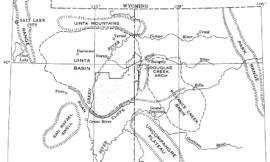Justin and I talk about when mineral rights are considered dormant, why this can be an issue, and what states have enacted statutes to address this. Given the decrease in activity across the US due to low commodity prices, it is likely that more acreage will fall into this category. Listen now to find out what you need to do to protect your interests and where you can go to find out more information.
Using the embedded player above, you can download the episode to your computer or listen to it here! Be sure to also subscribe on iTunes!
What is the Definition of “Dormant Mineral Rights”?
- Minerals that have not been developed or ownership transferred within a certain time period usually defined within the statute or act in a given state
- A dormant mineral statute or act is basically a law passed within the state legislature that addresses the issue of severed mineral rights where the owner cannot be located.
Why is this an Issue and How do Mineral Rights Become Dormant?
As you know, mineral rights can be severed from the surface rights. Severed mineral rights are often passed down through generations becoming more and more fractionalized over time. Title issues may exist where the owner of record with the county courthouse still shows up as the decedent.
Issues can present themselves if a company looks to explore or develop minerals and they cannot locate the owner of the interest. It is not uncommon for the heirs of the severed mineral interest to not even be aware that they have inherited the interest. This is especially true in areas where there has not been any oil and gas activity since the original owner died.
When an operator goes to drill a well, they go through the process of getting a drilling title opinion to find out who owns the mineral interests so that they can ensure that all interest owners are leased before the well is drilled. To find out more about title opinions, listen to Episode 60 with Liana Jones.
Since the operator may not be able to locate the owner of record because of the issue mentioned earlier regarding some interests still showing up as being owned by the decedent. If they move forward and drill the well with unleased mineral interest owners in the drilling spacing unit, it could cause legal issues for the operator.
These title issues only get worse over time as minerals are handed down and further sub-divided each time an owner dies. To address this issues, many states have passed dormant mineral statutes or acts.
Why do Dormant Mineral Statutes or Dormant Mineral Acts Exist?
The theory is that by enacting legislation to allow the termination of dormant mineral interests, states can help clear up title to the interests and address the fractionalization of mineral interests to enable development of these minerals.
In some cases the statutes protect the interests of the surface owner and provide a mechanism for them to regain ownership in minerals below their property.
In other cases, the statute or act protects the interests of the mineral interest owner who cannot be located and prevents a taking of their property while addressing the issue of being able to lease the abandoned minerals allowing the oil and gas to be developed.
Who Gets Abandoned or Dormant Mineral Interests?
The person or entity that takes ownership of the dormant mineral interest depends on the state and the language in the statute or act for that state. In some cases, the dormant mineral interest must go through a defined process but ultimately reverts back to the current surface owner. In other states, the interest could remain with the unlocatable mineral interest owner but be placed in a trust on their behalf. In both cases, the intent is to clear up title and allow for development of the abandoned or dormant mineral interest.
What are Some of the Complications Associated with Dormant Minerals?
Clearing title to dormant minerals can cause issues when the mineral owner desires to retain the interest in question. In order to determine if a mineral interest is considered dormant or abandoned, a judicial proceeding is usually required. The result of these proceedings determine if minerals are indeed dormant and if they should revert to the surface owner or other owner (as dictated by the state statute or act).
Two Examples of What Happens With Dormant Mineral Interests
As mentioned earlier, what happens to dormant mineral interests is dictated by the specific statute or act within that state. To provide an example of two different outcomes, we took a look at the dormant mineral acts in Ohio and Pennsylvania.
The Ohio Dormant Minerals Act says that in order for a mineral interest to be considered abandoned, you have to prove that the mineral interest hasn’t been used for the preceding 20 years. In other words, no drilling permits were issued, no oil or gas was produced, or the owner didn’t record an affidavit preserving their interest in the mineral interest. The outcome of a mineral interest being considered abandoned and the surface owner going through the requirements outlined in the statute is for the mineral interest to revert to the surface owner. So it essentially it is a mechanism for transferring title to the surface owner for abandoned mineral interest.
In Pennsylvania on the other hand, there is a different take on the problem by allowing anyone with an interest in oil and gas to petition the court to create a trust on behalf of the unknown interest owners. The party that petitions the court to create this trust can own the minerals, a royalty, or a lease.
In effect, the Pennsylvania Dormant Oil and Gas Act protects the unknown or missing owners of oil and gas interests:
Any person who owns an interest in oil and gas underlying a tract of land may petition the appropriate division of the court of common pleas of the county in which the tract or any portion of the tract is located to declare a trust in favor of all unknown owners of an interest in the oil and gas underlying the tract whose identity, present residence or present address is unknown and cannot be determined by diligent efforts.
Excerpt from Section 4 (a) of Pennsylvania Dormant Oil and Gas Act
This provision allows the trustee to lease the affected minerals on behalf of the unknown mineral interest owners which helps address the issue of drilling a well when the unknown owners’ interests remain un-leased.
The moral of the story is that it depends on the state where the minerals are located as to what needs to be done to protect the interest if you have undeveloped minerals that have been that way for many years.
It is important to look into how any potentially dormant minerals that you may own are treated in the state where they are located. You may need to take action in order to protect your interest. For example, if you are located in Ohio then you may need to record a claim that preserves your interest in the affected minerals. See this article from the American Bar Association about 5 Things You Should Know about the Ohio Dormant Mineral Act.
What to do if you Own Dormant Mineral Rights?
As with any legal matter related to your mineral rights or royalties, you should hire a qualified attorney licensed to practice in that state who is familiar with mineral rights law. They can help guide you and help prepare any paperwork that may be required to protect your interests, like an affidavit or other claim that preserves your interest in the affected minerals.
Resources Mentioned in this Episode
- Dormant No More: Fracking Boom Causes States to Revist Dormant Mineral Statutes
- Dormant Minerals Acts and the Marcellus and Utica Shale Plays
- Dormant Mineral Statutes: Reuniting The Mineral Interest With The Surface Of The Property In The New Era Of Advancing Technology (Contains list of states that have dormant mineral statutes and those that do not).
Thanks for Listening!
To share your thoughts:
- Leave a comment or question below (we read each one and your question may be featured in a future episode)!
- Ask a question or leave us feedback via email or voicemail: (720) 580-2088.
To help out the show:
- Leave an honest review on iTunes or wherever you get your podcasts – we read each one and greatly appreciate it. Plus, you can get a shout out on a future episode!
Thanks again – until next time!
Disclaimer: The information contained on this website and in the Mineral Rights Podcast episodes should not be construed as legal advice on any subject matter. All information, content, and references on this site are for general informational purposes only. This website links to other third-party websites. These links are provided as a convenience to our listeners/readers and the Mineral Rights Podcast and the hosts do not recommend or endorse the contents of the third-party sites. You should not act or refrain from acting on the basis of any content included in this episode without seeking legal advice from counsel in the relevant jurisdiction.




